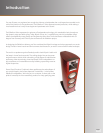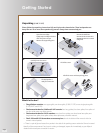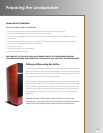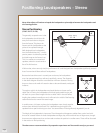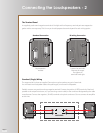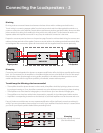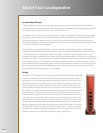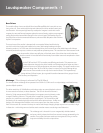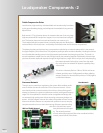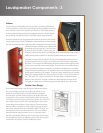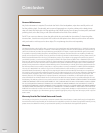
Page 11
Connecting the Loudspeakers - 3
Bi-amping
Connecting each loudspeaker drive element to separate amplication oers the highest possible performance
level. It is not necessary for the ampliers in the treble and bass sections to be identical. In fact for tube ampli-
er enthusiasts, there are advantages to using smaller ampliers in the treble and midrange sections as the
smaller transformers oer the signicant possibility of extended, sweeter treble response.
Tomulti-amp,thefollowingcriteriaareessential:
• The ampliers should be phase coherent. In other words, all ampliers should be, by design, phase non-invert-
ing or phase inverting; or if not, should be connected so as to be all phase non-inverting or phase inverting.
• The ampliers must have identical voltage gains, or should be set up to have identical voltage gains.
• The ampliers must have low residual noise characteristics, especially in the midrange and treble sections.
• Ampliers in corresponding channels must be identical; i.e., both bass ampliers must be the same and so on.
If any of the above conditions are not met, separate amplication will be signicantly worse than ordinary bi-
wiring. If you are unsure about these concepts or unsure if your ampliers meet these criteria, it is essential that
you consult your Klipsch specialist dealer before proceeding further.
Bi-amping
The mid/treble amplier is bi-wired
(One channel shown)
Bi-wiring
Bi-wiring reduces unwanted interactions between the bass drivers and the midrange and treble units.
True bi-wiring is connecting separate cables from the bass terminals and the midrange/treble terminals to a
common connection at the amplier. Several cable manufacturers produce specialzed cables, where one cable
jacket contains four cables, thus enabling bi-wiring within one cable cluster. This eliminates the need to run
separate cables and simplies connection. In any case, the method of connection is the same.
Prepare the crossover panel as shown on the previous page. Proceed as with standard wiring, but connect one
cable to the bass terminals of the speaker. Connect a second cable to the midrange and treble terminals. Refer
to the diagram. After connection, tighten all the terminals with the supplied wrench as shown previously.
HFHF
RightSpeaker LeftSpeaker
AMPLIFIER
MID /
TREBLE
AMP
BASS
AMP
Page 11



